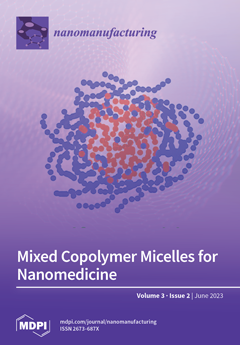Silver nanoparticles (SNPs) can be produced by active and inactive forms of biomass, but their properties have not been compared. Recent research is attempting to reveal their differences in shape, size, amount, antibacterial activity, cytotoxicity, and apoptosis induction. The biomass of
Fusarium oxysporum
[...] Read more.
Silver nanoparticles (SNPs) can be produced by active and inactive forms of biomass, but their properties have not been compared. Recent research is attempting to reveal their differences in shape, size, amount, antibacterial activity, cytotoxicity, and apoptosis induction. The biomass of
Fusarium oxysporum was divided into four groups and pretreated in the following devices: room temperature (RT) and refrigerator (for preparation of active biomass forms), autoclave, and hot air oven (for preparation of inactive biomass forms). Samples were floated in ddH
2O, and SNPs were produced after the addition of 0.1699 g/L AgNO
3 in the ddH
2O solution. SNP production was confirmed by visible spectrophotometry, transmission electron microscopy (TEM) and X-ray diffraction (XRD). SNPs were washed, and their concentration was determined by measuring atomic emission spectroscopy with inductively coupled plasma (ICP-OES). For antibacterial activity, the plate-well diffusion method was used. MTT and Annexin V-FITC/propidium iodide assays were used for cytotoxicity and apoptosis induction, respectively. The maximum absorbance peaks for SNPs pretreated in RT, refrigerator, autoclave, and hot air oven were 404, 402, 412, and 412 nm, respectively. The SNPs produced were almost the same shape and size, and the XRD results confirmed the presence of SNPs in all samples. Due to the differences in the type of bacterial strains used, the SNPs produced showed some differences in their antibacterial activity. The MTT assay showed that the amounts of SNPs in their IC
50 dose based on the results of ICP-OES were 0.40, 0.45, 0.66, and 0.44 ppm for the samples pretreated in the hot air oven, autoclave, and refrigerator, and RT, respectively. The apoptosis induction results showed that the biologically engineered SNPs induced more apoptosis (about 34.25%) and less necrosis (about 13.25%). In conclusion, the type and activity of SNPs produced by the active and inactive forms of fungal biomass did not change. Therefore, use of the inactive form of biomass in the future to avoid environmental contamination is reccommended.
Full article



